How To: Ham Stand From a Table Leg
by JavitoBosch in Workshop > Woodworking
3305 Views, 13 Favorites, 0 Comments
How To: Ham Stand From a Table Leg
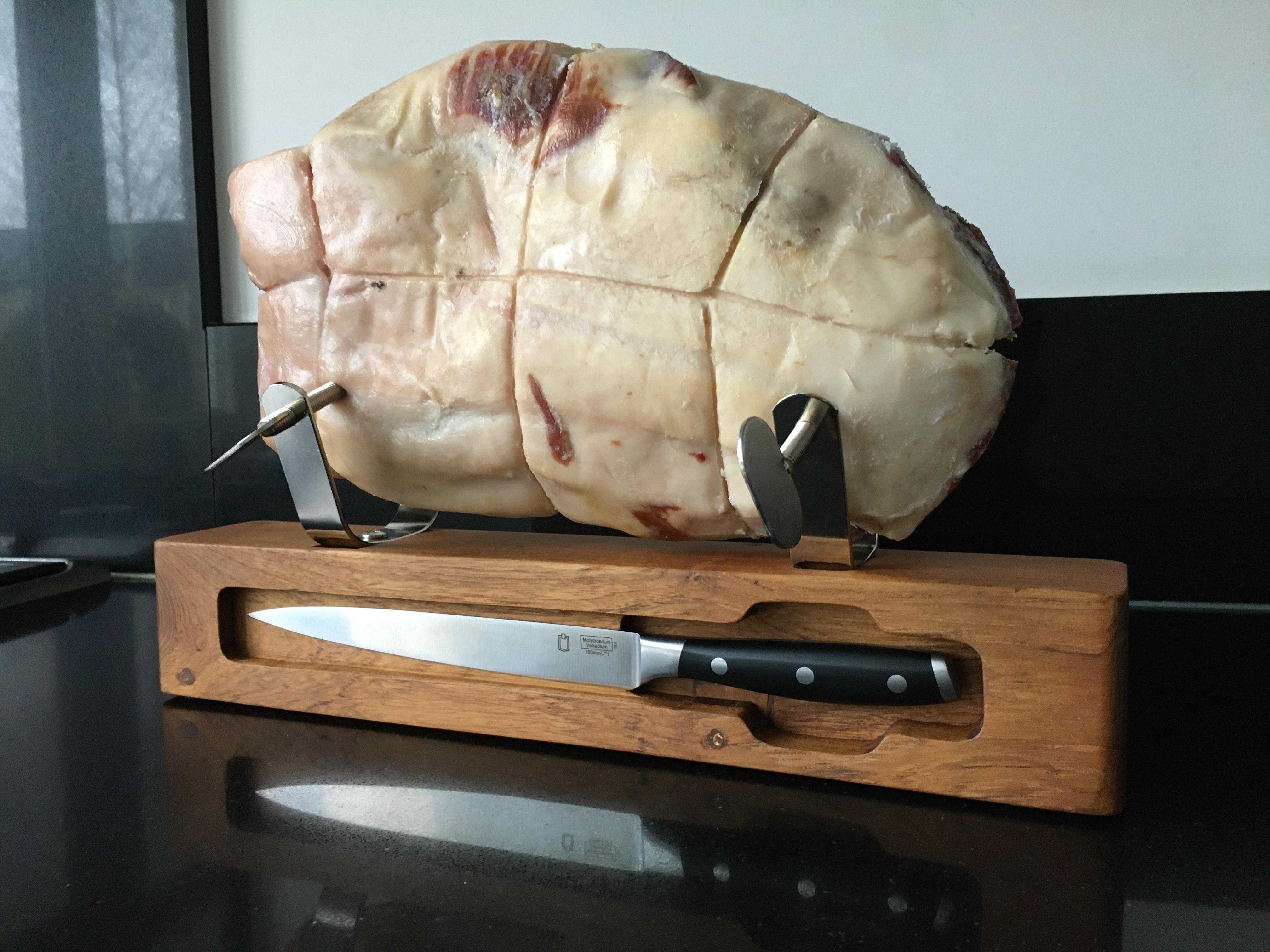
Quick summary of what you may encounter if you keep reading:
What am I doing?
I am building a boneless Spanish ham/prosciutto stand with one of the legs of the Teak Coffee Table that I used for my last project (link)
This idea works for ham, cheese or anything you have in mind!
Why am I doing it?
Having a Spanish ham leg at home for Christmas is part of the Spanish tradition, so every Christmas my grandfather used to purchase a ham leg and I had to wait patiently until he would ask me to start slicing this delicious ham.
Now I am living abroad and the desire remains (and the memories too). I had the chance to fly to Barcelona and I was lucky enough to get a small boneless ham leg that I could keep in my cabin luggage. I arrived home and realised that I don’t have a ham stand, but I could build one…
How am I doing this?
Well, as mentioned before, I still have wood from that Teak Coffee table, so I decided to use one of the “useless” legs for something actually useful (reusing, repurposing, and so on)! The idea was to use as little machining as possible and provide the nicest look to what it would be my first ham stand…the way I always wanted it to be.
If you want to make one for yourself, keep reading. If you prefer to purchase one, I am making 2 more and you can purchase one from my store.
Supplies
Components:
- A table/desk leg or something similar (e.g. squared-profile wooden beam)
- 6x2mm NdFeB nickel-plated magnet disks or similar. N35/N52 are more than perfect for this project.
- Ham holding brackets. These ones are nickel-plated, despite of the supplier mentioning that is stainless steel. I just wanted to give you the idea.
- A knife. Ideally, a thin blade, flexible and not excessively long (opposite to the traditional knife). In my case, I am using a knife that is shorter than 30cm.
Power/Hand Tools:
- Table saw or similar for trimming (if needed)
- A router machine with the corresponding bits. I used a straight R9,5mm bit for all operations. Same size for rounding edges
- A drilling machine for making the holes for the magnets and the screws. The diameter used here is 6mm and 5.5mm, respectively
- A sanding machine (or your hands) with various sanding papers (P120, P180, P240)
- A handsaw for trimming wood trimmings/remainings
- A pen/pencil/marker and a ruler for measuring
- Screwdriver set
- A paint brush
- A lint-free cloth
- A few rugs to remove dust and dampen the surfaces
Materials:
- Wood oil
- Wood wax
- Wood glue or similar
- Wood dust from other projects, but if possible form the same wood
- Wood bits
- Polyurethane-based glue
- Cyanoacrylate glue
- Rubber sheet (e.g. bike inner tube)
- Masking tape
- ~1cm diameter disk (e.g. a coin)
Drawings (optional):
- I decided to set a symbolic price for what I am doing, so you can get the drawing from my shop.
Skills:
- Patience and be willing to spend a nice and enjoyable time getting full of wood dust
- Some experience with the router machine is appreciated
Design Requirements and CAD Modelling
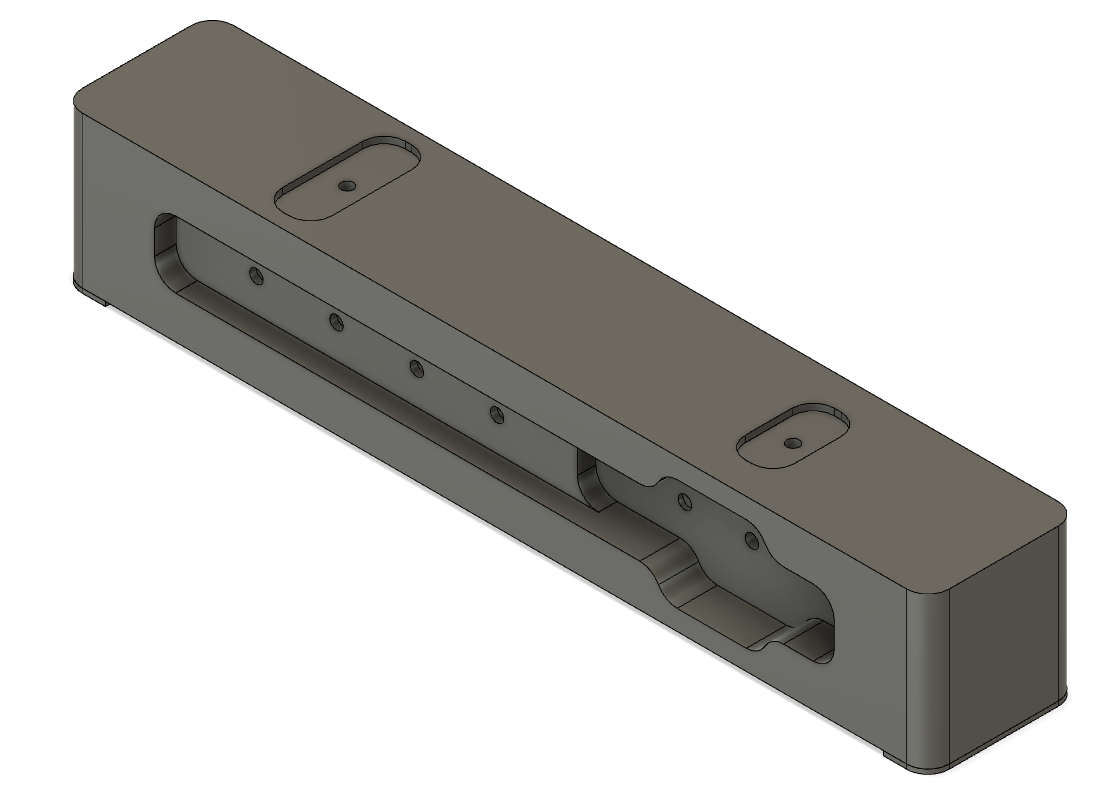
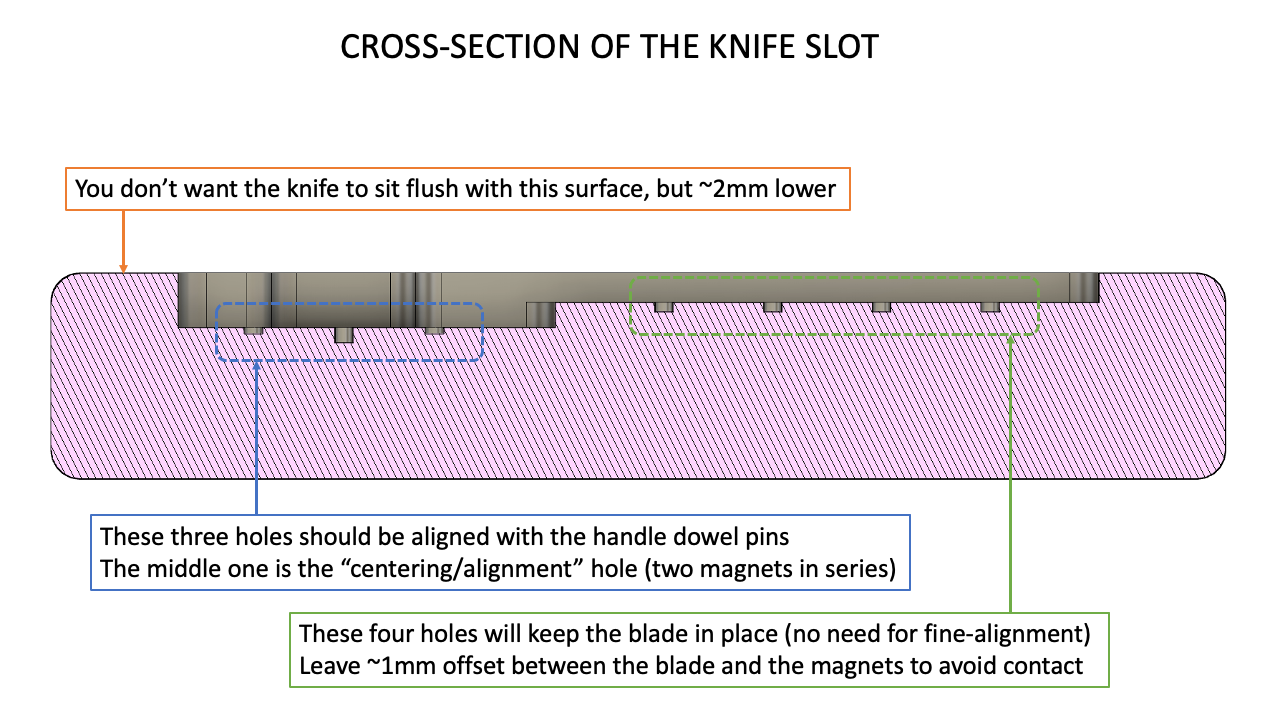
Main disadvantages of conventional (affordable) Spanish ham/prosciutto stands:
- They are bulky and hard to store once they are not used as I only use it once a year
- There is no smart/functional storage for the knife. You always have to look for it and end up loosing it
- Materials used are usually not up to the expected quality
- Other options become unaffordable/pricey (e.g. professional stainless steel stand)
Design requirements
- I want a stand that can be easily disassembled with a screwdriver or similar
- I also want it to be easy to store, without taking too much space
- Of course, a dedicated magnetised slot for the knife (I love magnets!)
- The dedicated knife storage should be easily accessible for people with chunky fingers
- I should be able to center the knife in the pocket easily, always keeping the same position
- I would like to reuse some scrap wood
CAD modelling
- I would advice to take basic measurements and make a model of the piece of wood. We will fine-tune the dimensions later.
- Take dimensions of the knife. Bear in mind you will need to make two different depth levels for the pocket (see pictures). Also, you don’t want the knife to fit flush with the top surface, so allow an extra 2-3mm depth. You can consider this as your manufacturing window for errors.
- Place the holes for the magnets evenly distributed where the blade will be located. You don’t want the magnets touching and scratching the blade, so allow 1 mm offset between the blade and the magnets. You only need the magnetic effect and 1mm air-gap is more than enough.
- Most of the knife handles tend to have 2 or 3 dowel pins to keep the handle itself and the blade in place. These pins tend to be made of iron-based steel (they feel attracted by a magnetic field). I did my best to align them against the magnets. The handle has a rather circular cross-sectional shape, so I did not mind if the magnet sits flush with the wood. However, the middle pin had full contact with the wood. I decided to use this one as alignment, so I placed 2 magnets in series instead of one, leaving around 1mm offset with respect to the handle. The magnetic field is increased and therefore the alignment becomes intuitive.
- Apart from that, you need to make sure that the stand sits firm against any surface and does not slide when cutting ham, so I modelled some rubber pads.
- It is also a good idea to machine slots for the brackets that go on top (the ones that hold the piece of ham). This is because they only have one screw, making very easy the rotation/misalignment of the bracket once it is placed.
Pre-work: Filling the Gaps!
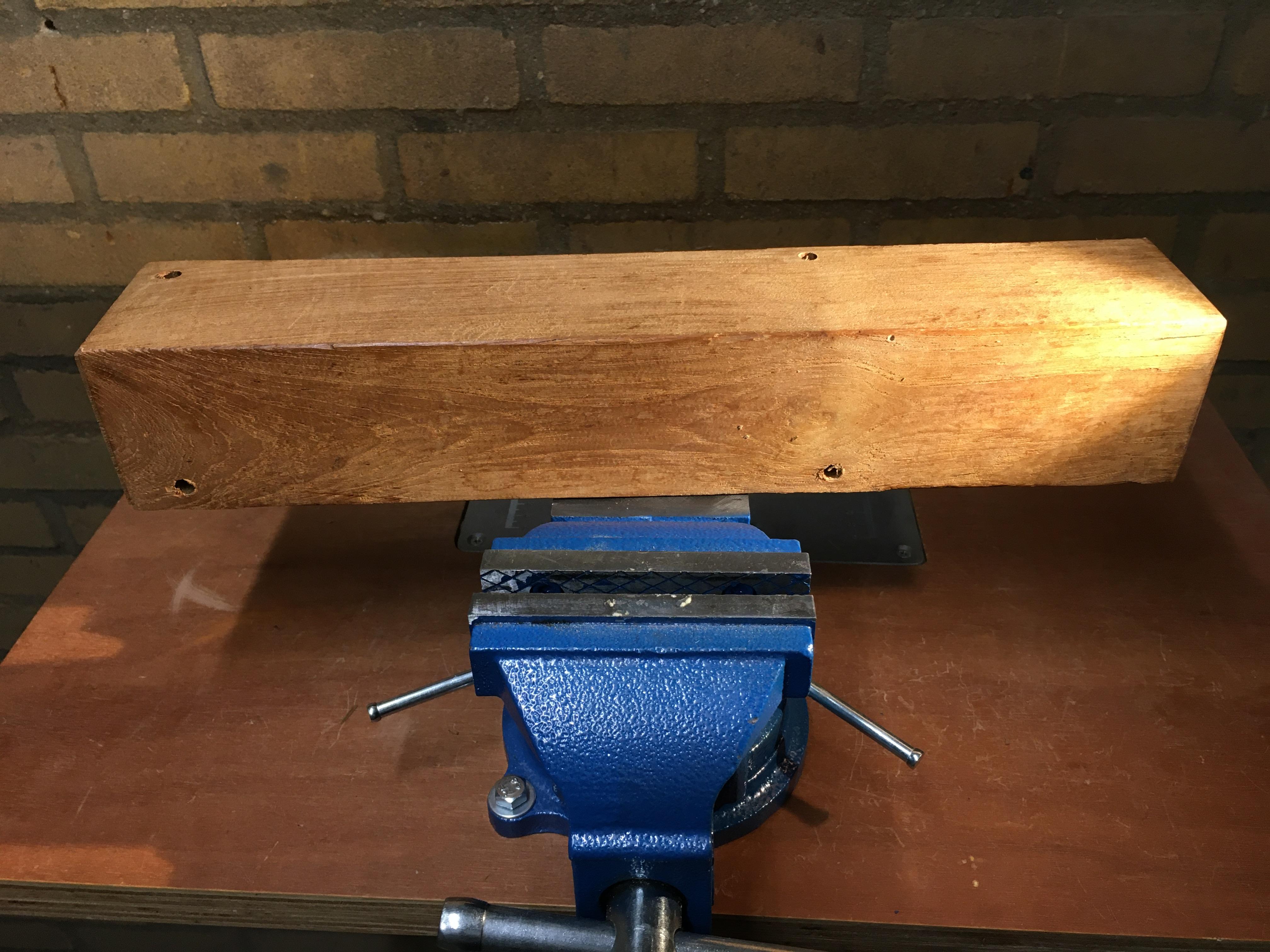
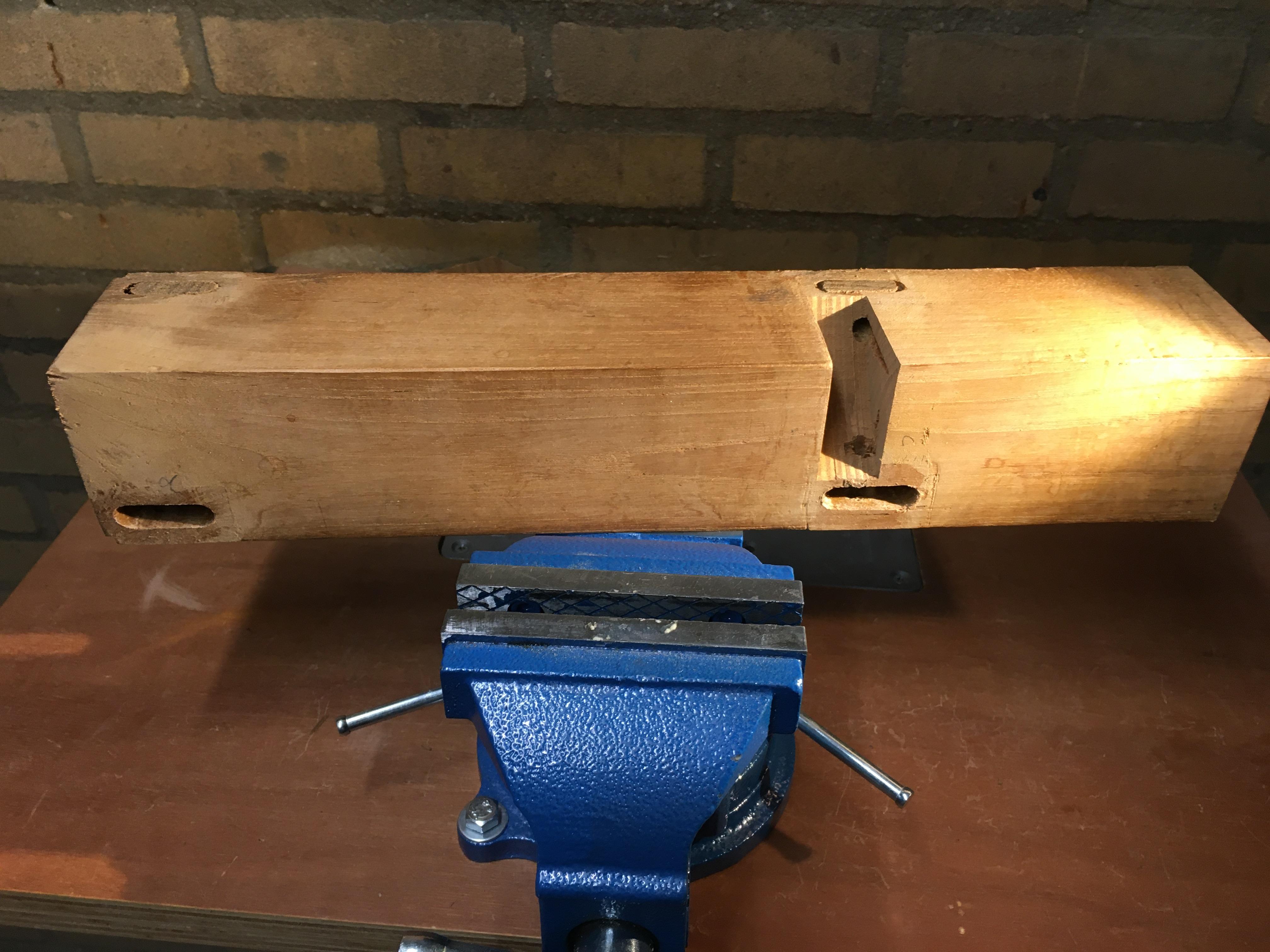
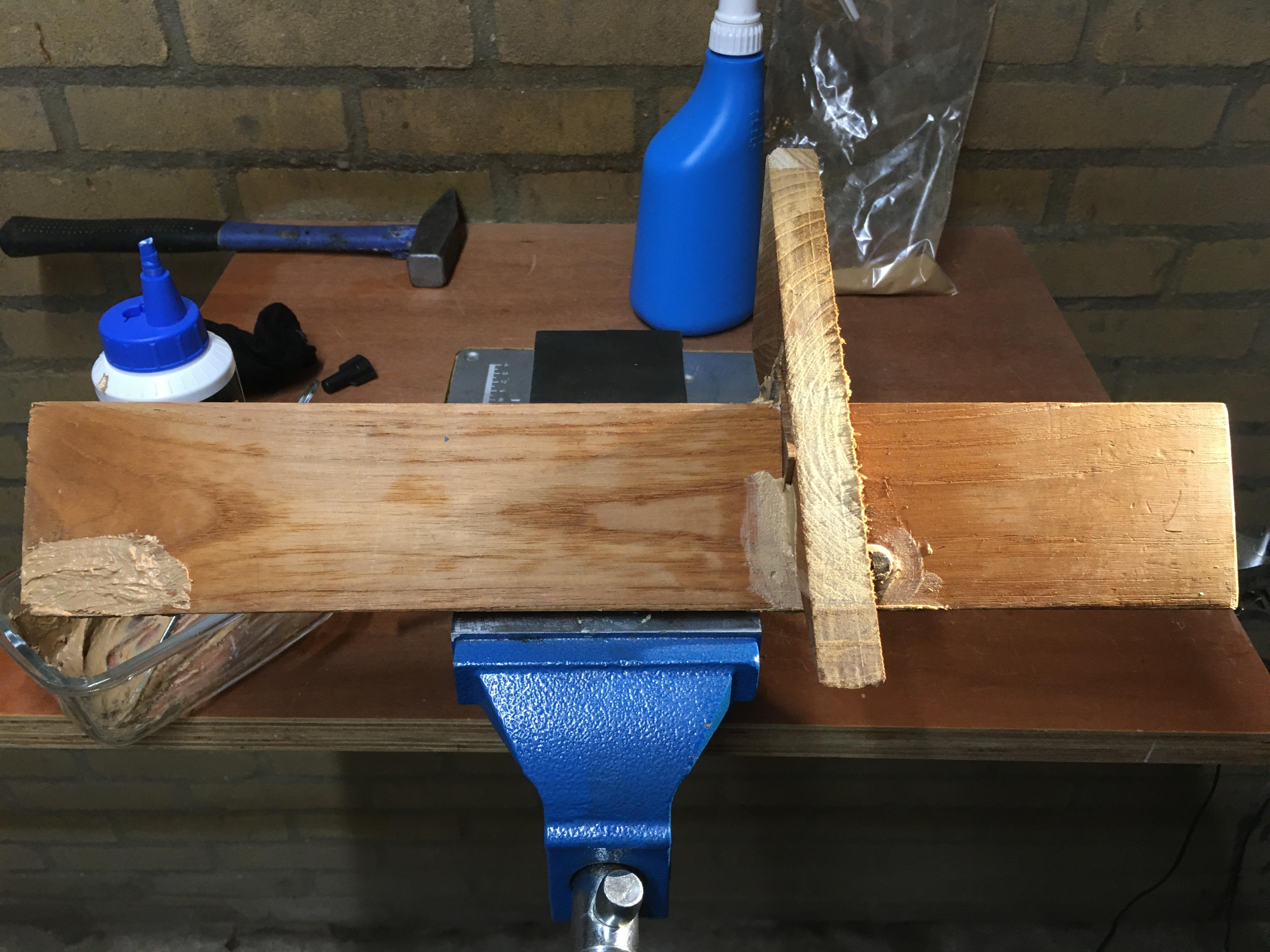
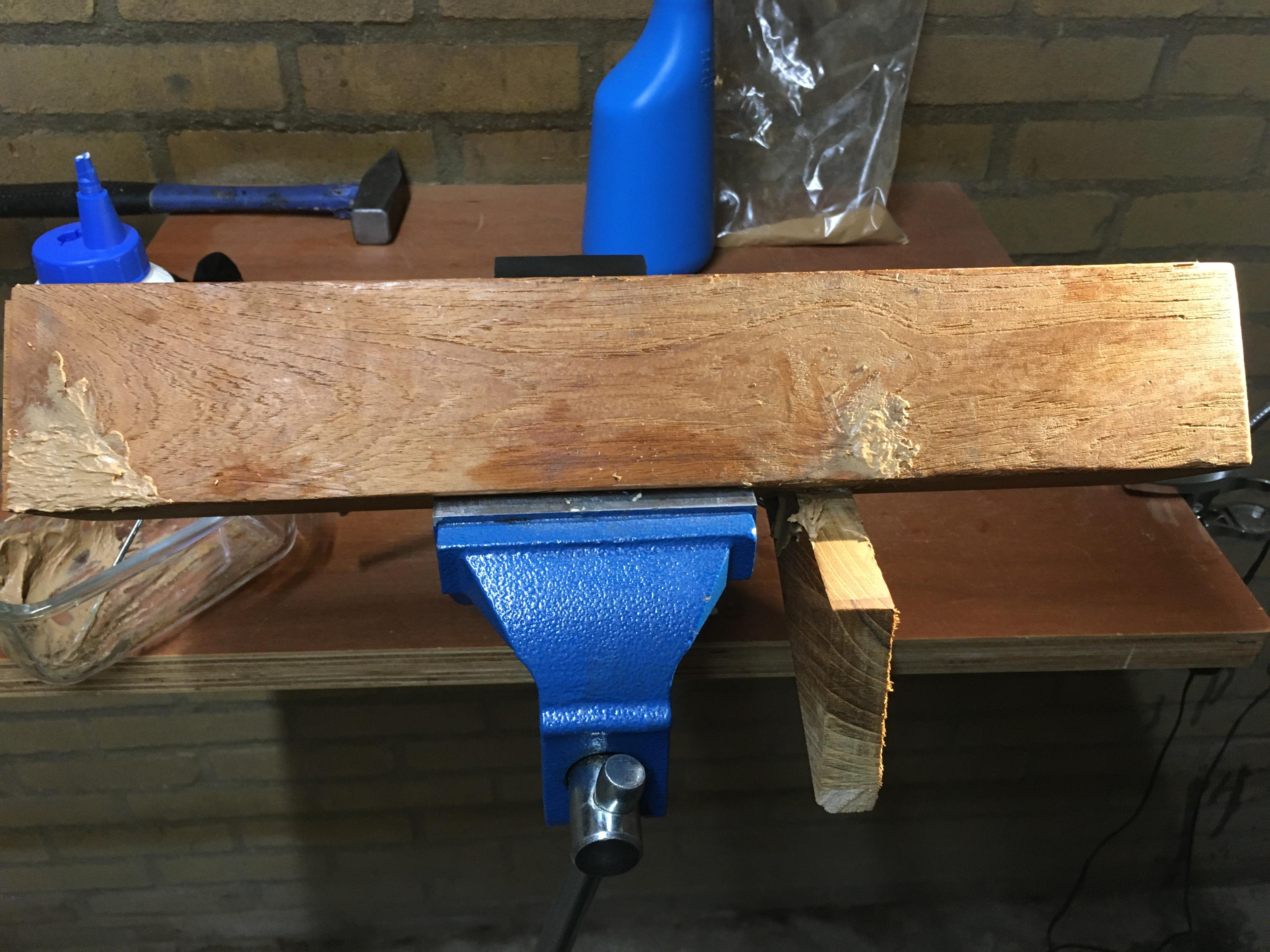
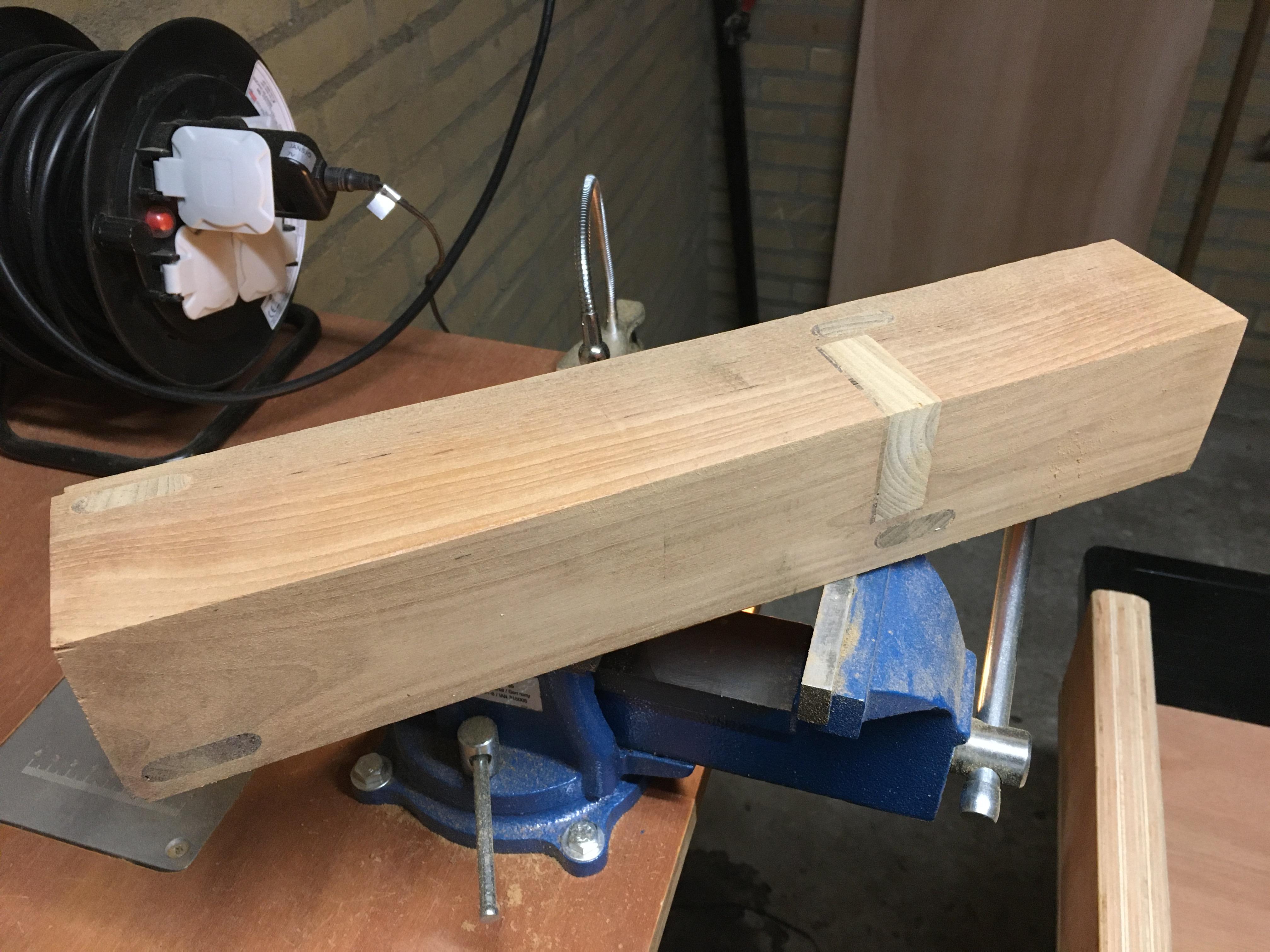
In this part, the main goal is to fill all the existing gaps from the previous use as part of another piece of furniture. You can get creative by using other materials or by highlighting these features. In my case I had some wood remaining from my previous project that I could reuse:
- Inspect the part and clean all hollow spaces. Decide what to do.
- Fill the gaps first with rather big wood bits (you might need to shape them) and then use a mixture of fine-wood dust and wood glue + some water to fill the volume left while gluing the parts together. I decided to place some wood with different grain orientation, just to see if it would look nice later.
- After you finished and the working part looks like something made by a 4-year-old kid (see pictures), I would recommend to wait for at least 2 days until we can make sure everything is bone-dry.
- Proceed by cutting any protruding remaining. Go ahead and sand! The aim is to have a smooth-wooden beam with filled gaps!
- Yes, you might find that there are uneven surfaces where the gaps were, or just not enough material. Hence, repeat the last steps as many times as necessary. Remember that this piece of wood will be seen from a very close distance, so let’s avoid silly mistakes.
Machining Time!
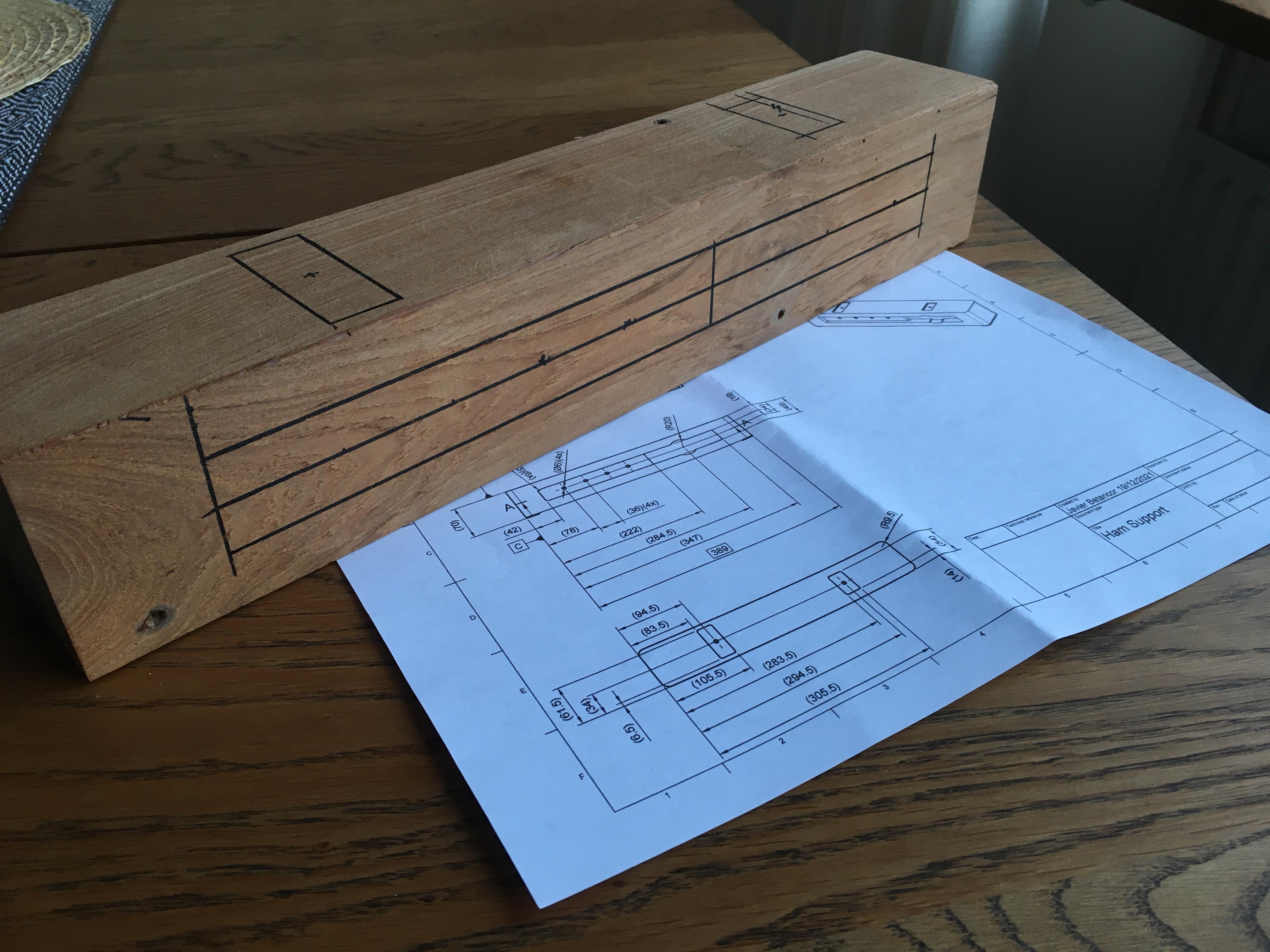
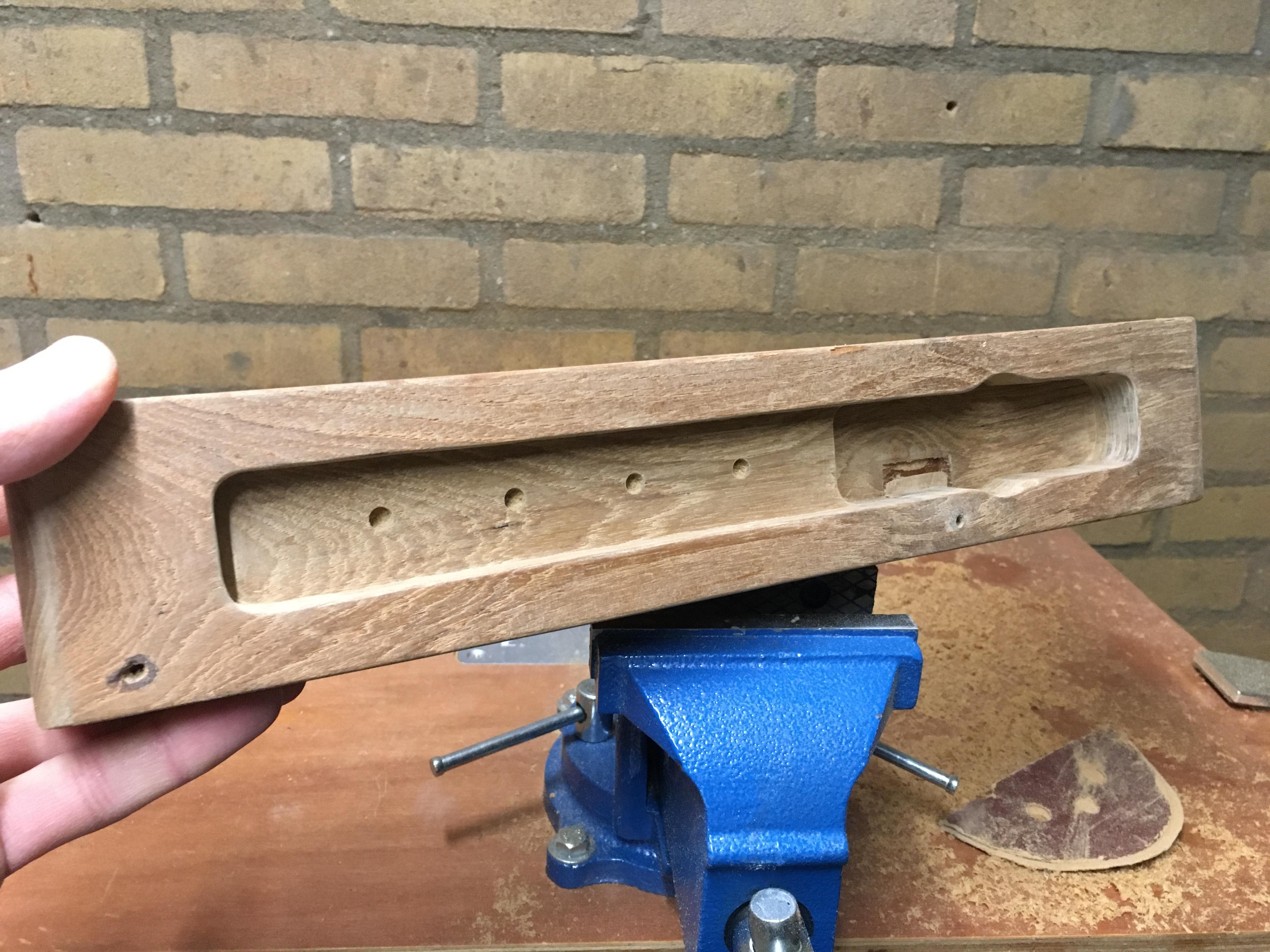
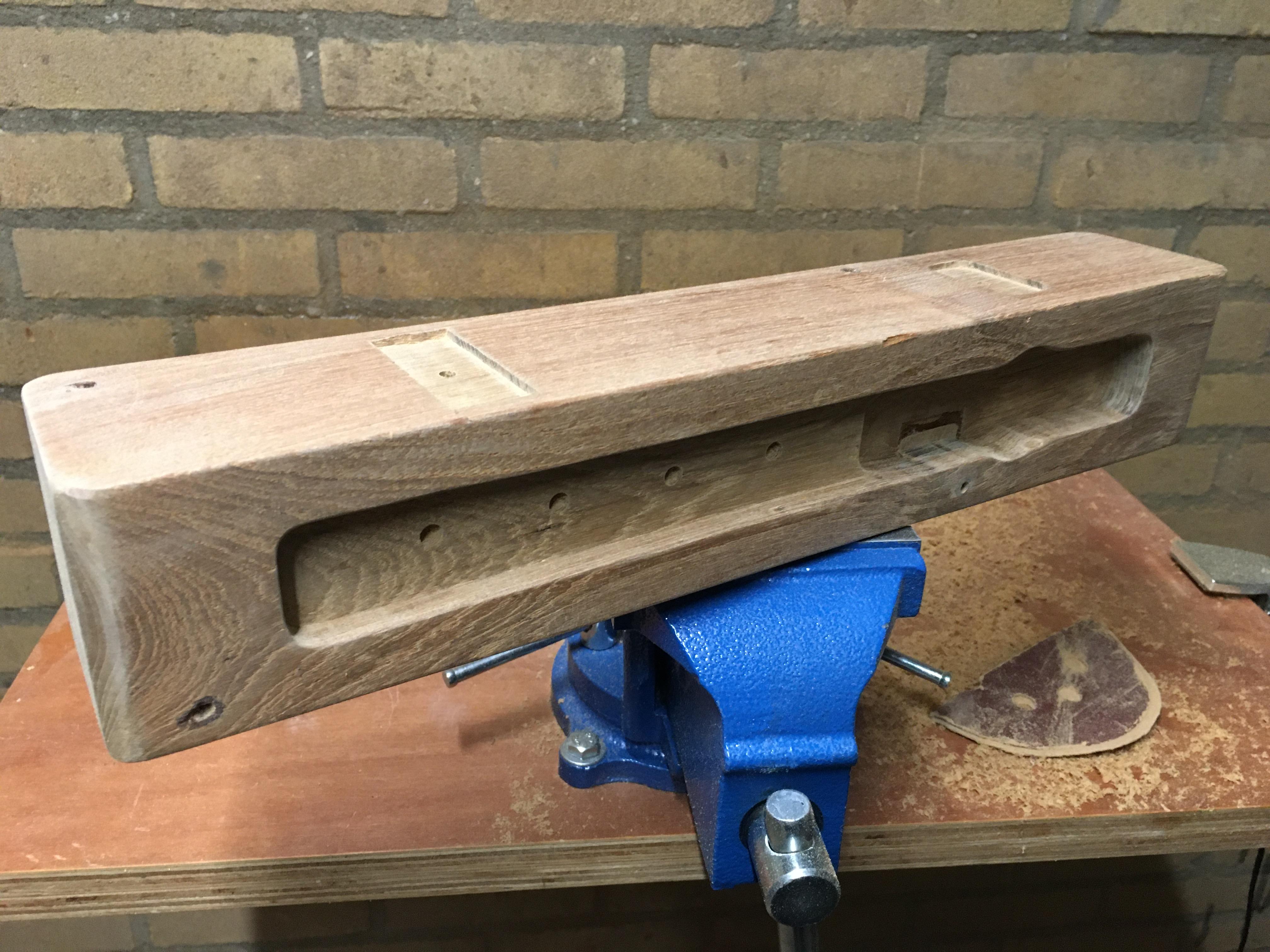
Happy with the result so far? I so, continue reading. If not, repeat Step 2:
- Grab a marker of your choice and mark all the holes and slots/pockets needed.
- I recommend starting by drilling the holes for the magnets and screws. You can set the desired depth on the drilling bit by sticking a piece of masking tape. Try to use the same diameter as the magnets, so you can press-fit them later.
- Router machine time! You need to perform this part in a few steps, so don’t set the router machine to the final depth and try to remove material. This will go wrong.
- The idea is to remove material without reaching the boundaries of what you drew before. This task can get complicated, so take your time. And no, I did not use any ruler/template. If you think about it, pockets 1mm deeper or wider will be of no issue.
- Time for fine-tuning or finishing. Now, take all the time needed to reach those marked limits, but bit by bit! It is very important that everything looks straight and at the same level. We want a masterpiece. It also helps if you have experience and feel confident using your own tools.
- I did not like the 4 straight corners showing that a wooden bean is a “squared-wooden beam” (you know what I am talking about), so I decided to round them using a rounding router bit.
- Happy with the machining part? Sand everything starting with a P120 grit and continue with a P180 grit. Make sure you remove any dents and imperfections! I also decided to break all sharp edges.
- Clean the masterpiece with a dry cloth and a damped cloth in order to remove any dust. You might need a brush or compressed air for the holes.
Assembly and Wood Finish
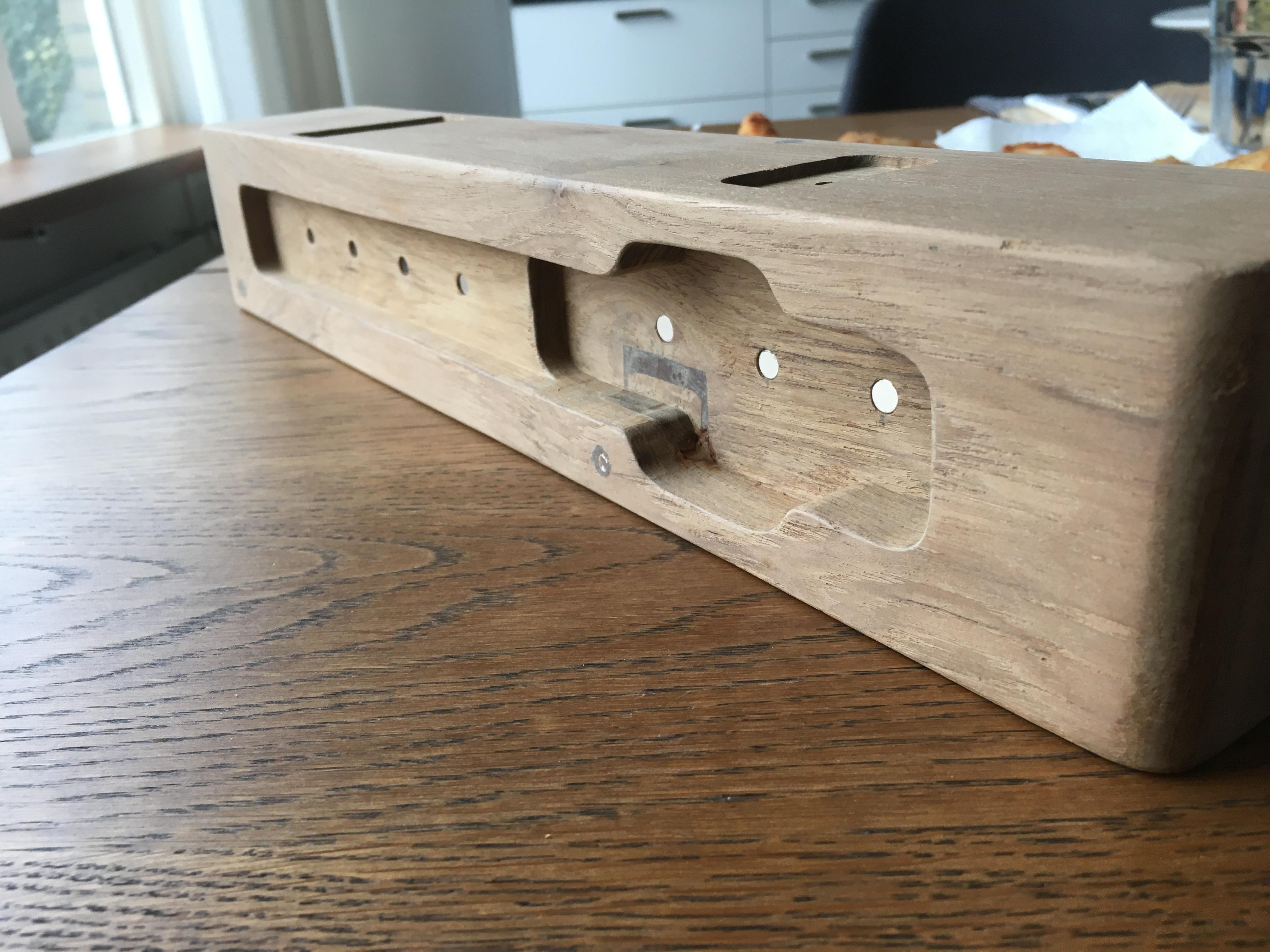

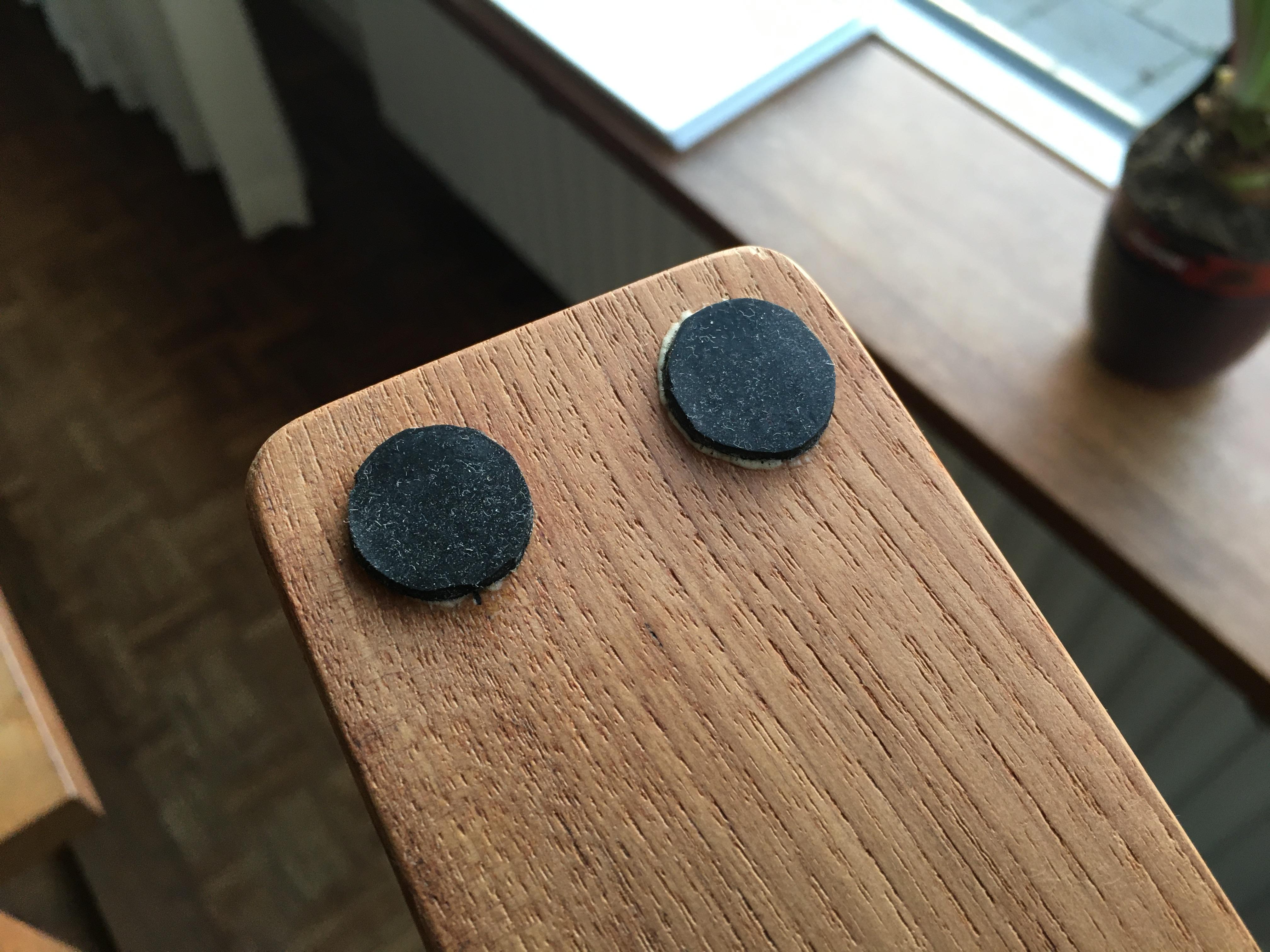
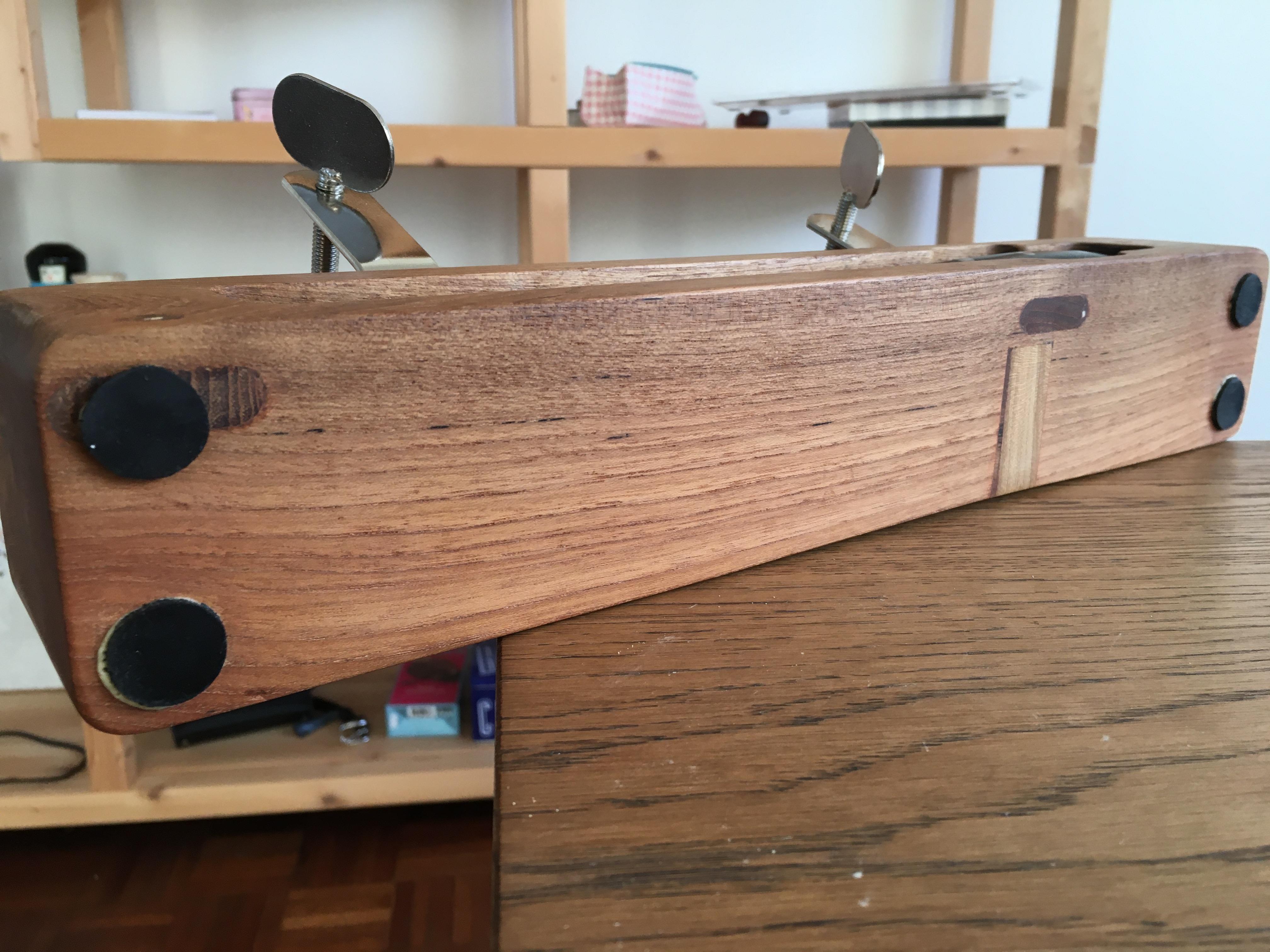
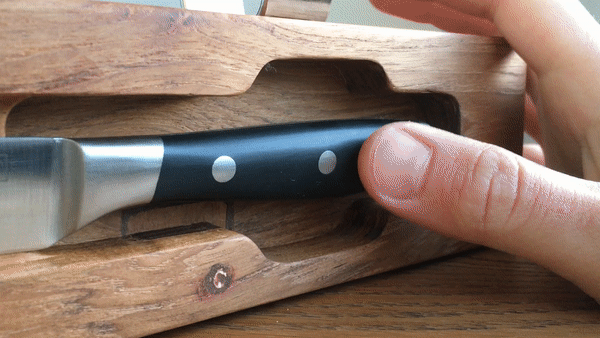
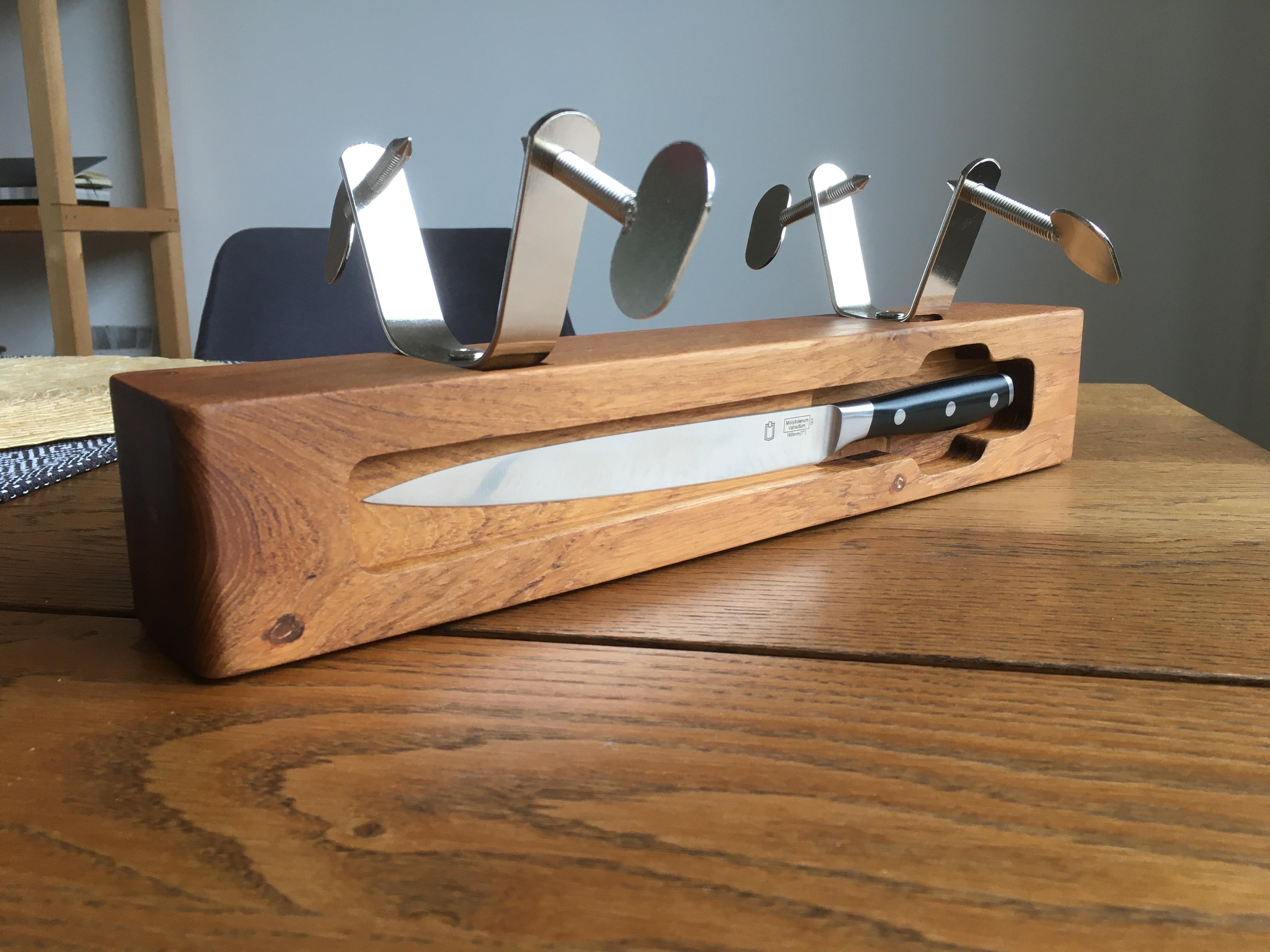
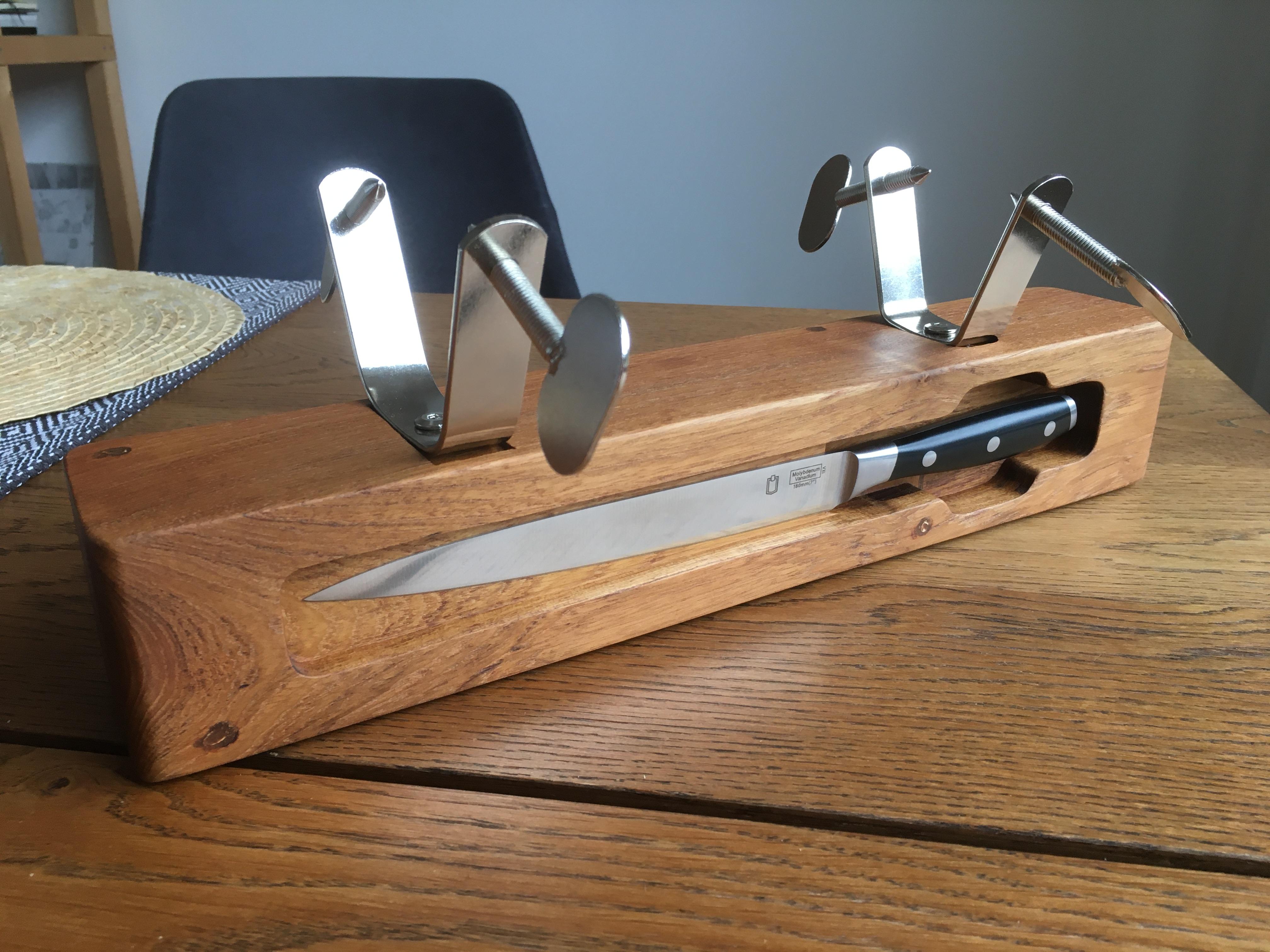
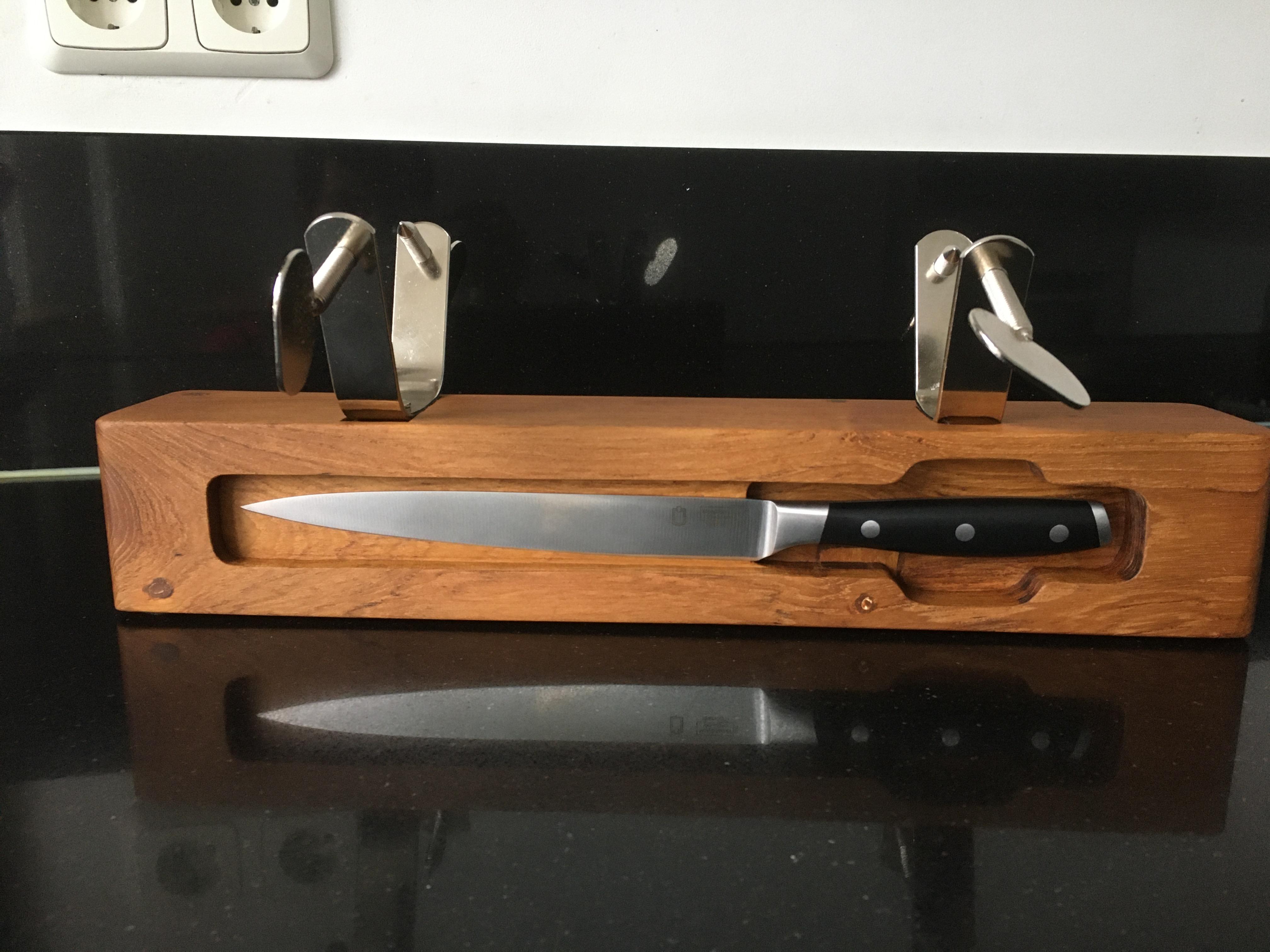
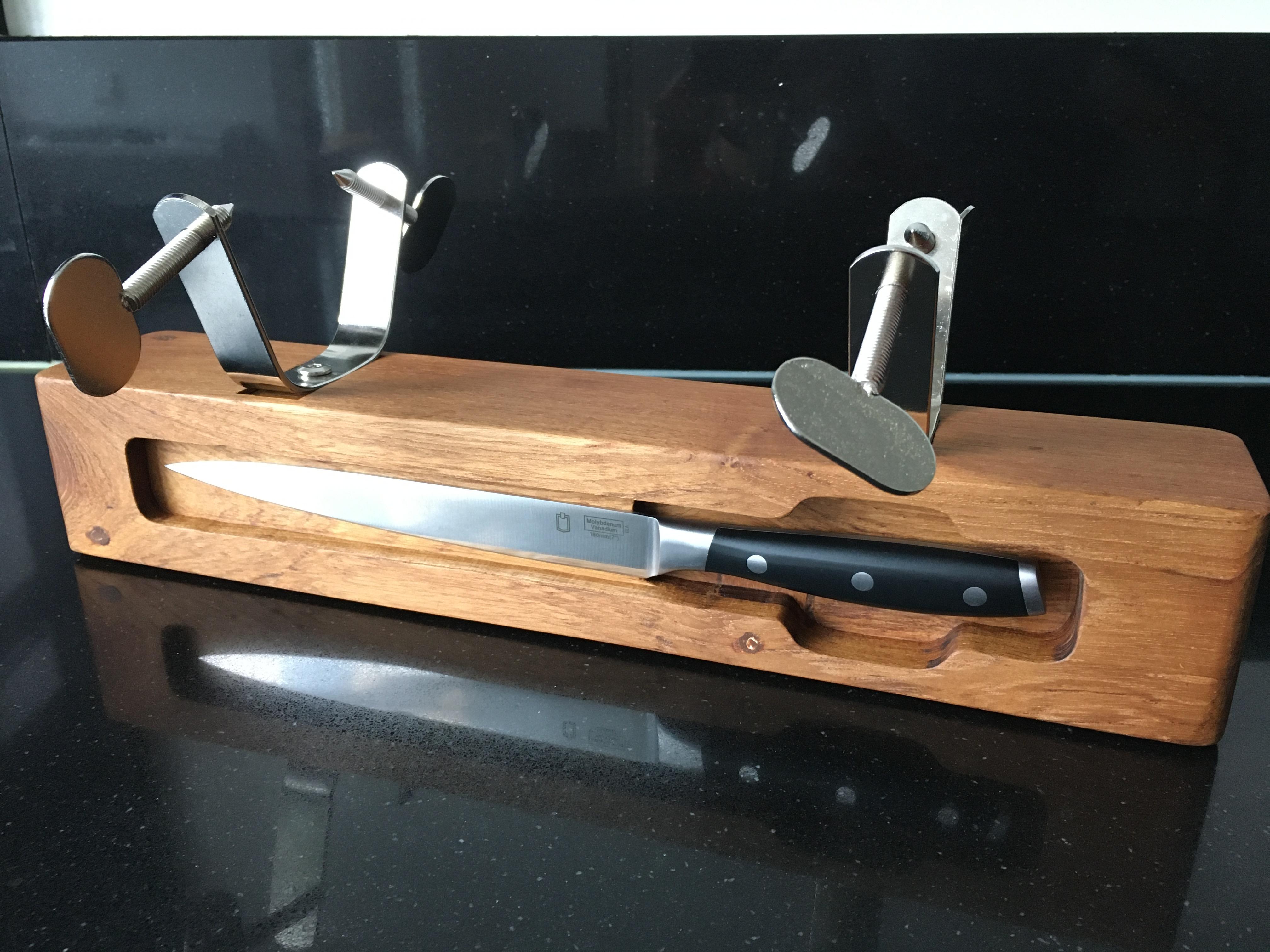
This is coming to an end, but be careful because this is the most important part:
- Time for gluing the magnets. These are nickel-plated magnets, so a polyurethane-based glue is recommended. Clean the magnets with IPA (orientation is not relevant) and dampen the drilled holes. Now, add some dots of glue (e.g. Gorilla glue) but not too much because it will expand later. Place and press the magnet until the desired depth. You can use the back of a drilling bit or a the back of a pen (made of plastic, like a simple BIC one).
- How can I glue two magnets together? Clean them with IPA and use a drop of a cyanoacrylate (or a quick “zero-gap” glue). Remember to apply glue in the right faces. This is useful for the magnet array that aligns with the knife handle.
- Now, sand the ham stand with a P240 sanding paper. Wipe the dust with a dump cloth.
- Use a disc of ~1cm diameter and cut 4 discs out of the rubber sheet. Sand one side slightly and clean thoroughly. You just created the rubber feet.
- Dampen the bottom of the ham stand (only where you are planning to glue), the rubber and apply a little dot of glue (Grilla glue is just fine). Place the rubber feet towards the inside of the ham stand. We don’t want them to be visible, but we want them to work! Wait for the glue to dry.
- Oil the ham stand. Be generous and respect the drying/curing times. You will see how the wood really changes color and this fantastic texture makes its appearance. I used a very fine brush, but a cloth should also be fine.
- Wax the ham stand for added protection. I used a thicker brush in this case (bee wax is really dense). I applied two layers within 20mins following the manufacturer’s recommendation. Wait for it to dry and remove with a lint-fee cloth. Be careful because you are now polishing the part! You will see how even the surface becomes. This also depends on the type of products you used. Let it cure and follow the manufacturer’s recommendations closely.
- After a day or so, take the brackets and fit them. Place the knife and the piece of ham. Enjoy!
Conclusion
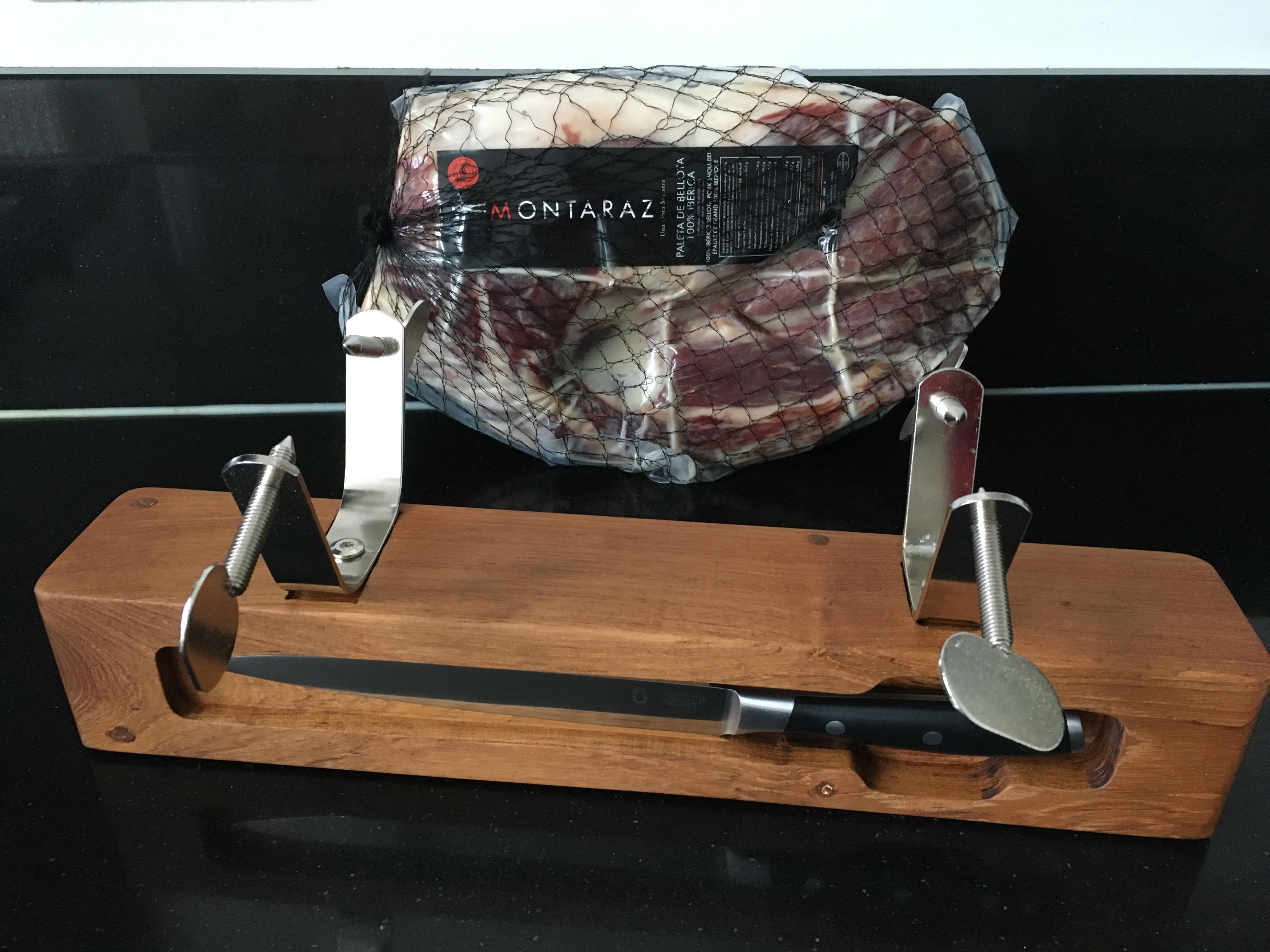
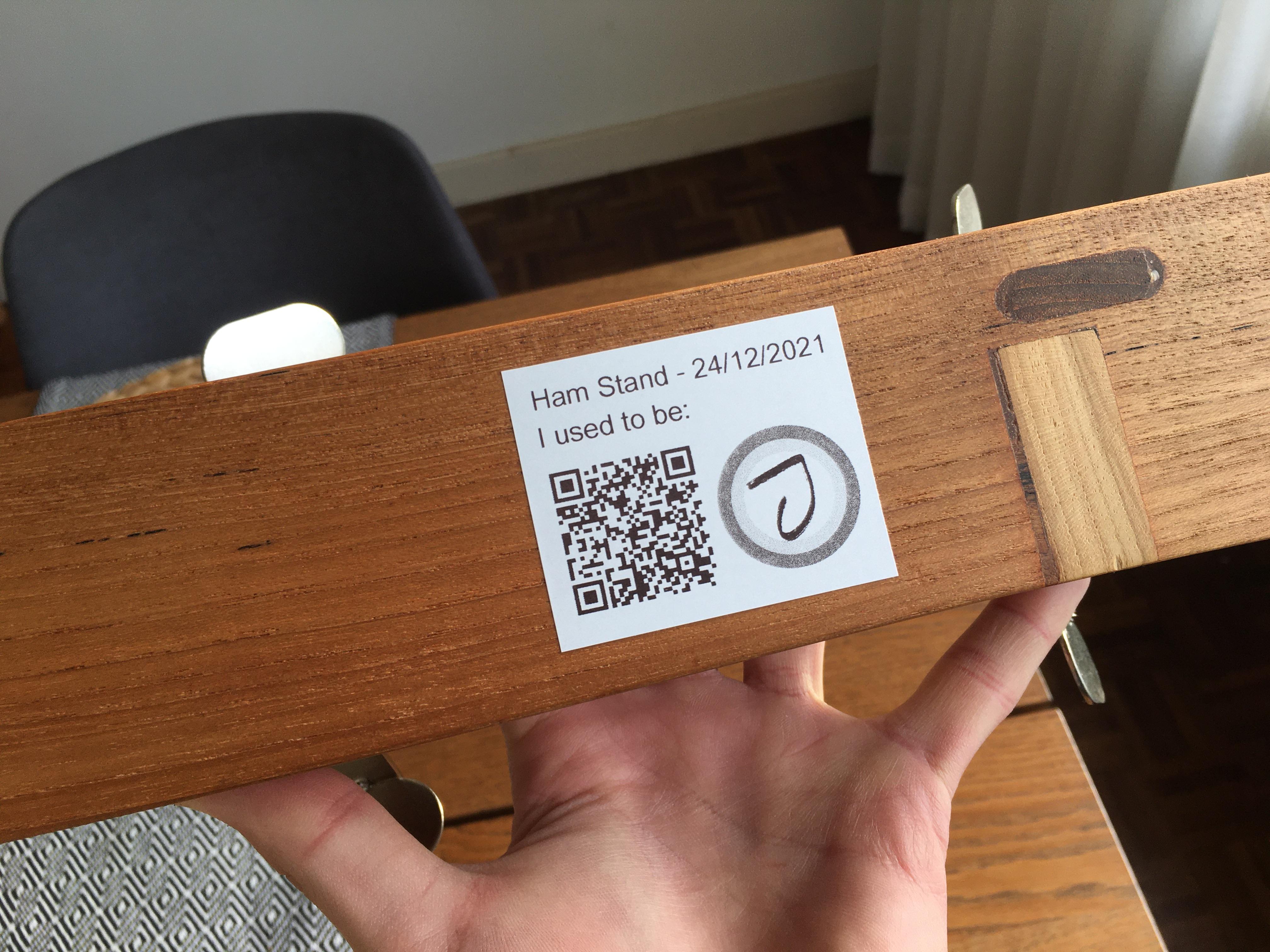
I think I made a good use of such a nice and good-looking wood. I am rather happy with the result, enjoying the look and functionality of this device.
If you scan the QR-code, you will be redirected to what this wood used to be part of in its previous life.
Constructive feedback is always welcome. I would also like to improve!
See you on the next one!